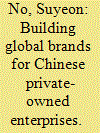|
|
|
Sort Order |
|
|
|
Items / Page
|
|
|
|
|
|
|
| Srl | Item |
| 1 |
ID:
161566


|
|
|
|
|
| Summary/Abstract |
While most private-owned enterprises (POEs) in China are engaged in subcontracting or do not own the product brands, the number of POEs with their own brands has increased rapidly, while some are even globally recognized. Since these POEs face high opportunity costs for own branding, given their dominant presence in the global subcontracting community, their own branding actions require contextual understanding of doing business in China. This study starts with the notion of how these POEs shift from subcontracting to own branding, and explores their respective own branding paths. We interviewed seven Chinese POEs in the fashion industry in Zhejiang Province: Babei, Baili, Sunrise, Aokang, Youngor, Kangnai, and JNBY. The case studies suggest how these firms built their brands in the global market, and why their trajectories differentiated in the course of own branding. Our study configures three types of own brand models for POEs: the competitive subcontracting, the toehold, and the home-linked organic models. POEs can continue subcontracting in their core business, while implementing own branding through diversification. Alternatively, they can segregate markets, pursuing own branding in one group of countries, while subcontracting elsewhere. In addition, they may establish wholly owned enterprises, and introduce their brands in a way that preserves their home market advantages. We identify two stimuli for Chinese POEs’ global branding choices. Global branding strengthens domestic position as it becomes a signal for reputation. As the online platform reduces costs for global branding, and becomes popular, POEs are more likely to pursue global branding to become more competitive in the domestic market. Many POEs also continue to collaborate with the previous customers through strategic inter-dependence, such as distribution channel exchange.
|
|
|
|
|
|
|
|
|
|
|
|
|
|
|
|
| 2 |
ID:
175060


|
|
|
|
|
| Summary/Abstract |
This study examines state-private firm coordination in China’s corporate globalization with a focus on cross-border mergers and acquisitions in Southeast Asia. The profile of China’s private firms in the country’s overseas economic expansion has risen dramatically over the past few years, but the controversy continues as to what extent they coordinate their overseas activities with the state. This is because Chinese private firms, not unlike state-owned enterprises, have political economy reasons to subject their corporate decision-making to state preferences. Still, the outcomes of state-firm coordination in private sector internationalization vary. In some transactions, the state and private firms form a strong partnership through elaborate policies and financing; others see some alignment that is not decisive for transaction outcomes; and still others see minimal, almost rhetorical engagement. The varied outcomes can be explained by the combination of foreign direct investment (FDI) motives and the technology intensity of the target industry. We propose a framework drawn from the international business theory of FDI motives and the literature on China’s techno-industrial policy to classify different types of state-private sector coordination. We survey recent developments in China’s cross-border acquisitions in Southeast Asia and provide illustrative case studies to support our argument.
|
|
|
|
|
|
|
|
|
|
|
|
|
|
|
|
|
|
|
|
|